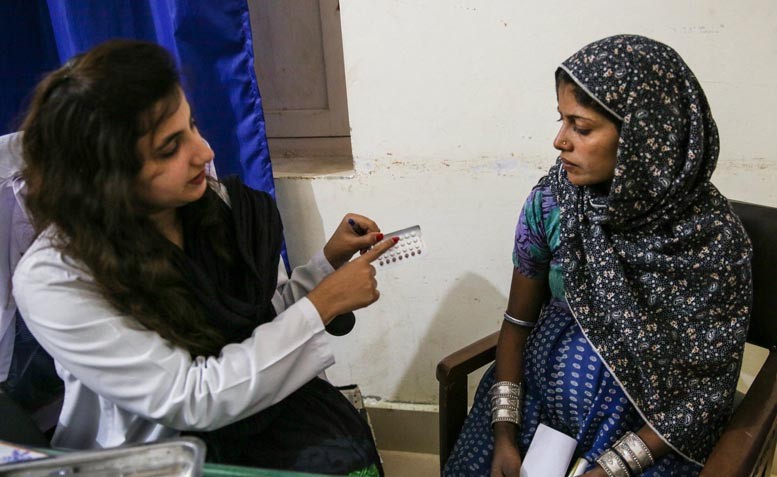
For Pakistan to climb the ladder of development indicators, the issue of family planning needs urgent attention

Pakistan may not be on top of any list on the development indicators like health, education gender equality and food security. It is, however, steadily climbing the ranks in the list of the world’s most populous countries. From the 6th most populous country in the world, Pakistan surpassed Brazil and became the 5th most populous country on the planet as its population surged above 220 million people, according to official numbers released in 2017 as a result of the nation’s first population census in two decades. If things keep going at this pace, we will climb up another rung by 2030 with a predicted 245 million strong population, and become the 4th most populous nation in the world.
While we are at it, let us talk more numbers. According to the latest Pakistan Demographic and Health Survey (PDHS) 2017-18, 52 percent of currently married women age 15-49 in Pakistan have a demand for family planning (FP), 19 percent for spacing births, and 33 percent for limiting births. Only 34 percent of currently married women are using a contraceptive method either to space or to limit births, and therefore have fulfilled their need. However, 17 percent of currently married women have an unmet need for family planning -- 10 percent want to space and 8 percent desire to limit births but are currently not using any contraception. If all married women who want to space or limit their children were to use a family planning method, the contraceptive prevalence rate (CPR) would increase from 34 percent to 52 percent.
Humans require developed ecosystems to survive and thrive, something that we are unable to provide to more than 220 million people. Of the 17 Sustainable Development Goals (SDGs), Pakistan is lagging behind at most. According to UNICEF, 23 million children between the ages of 5 and 16 are out of school in Pakistan, a whopping 44 percent of the total population in this age group. There are some five million children between the ages of 5 to 9 who are not in school, making it the world’s second-highest number of out-of-school children (OOSC) at the primary level. Not just this but also that gender-wise, boys outnumber girls at every stage of education. In Balochistan alone, 78 percent of girls are out of school. For every 10.7 million boys that are enrolled at the primary level, 8.6 million girls are enrolled, and dropouts of female students remain high. Health experts say that over 44 percent of Pakistani children under five years are stunted due to chronic malnutrition.
It is not that Pakistan is not working on these issues. Yes, clearly, the work is not enough, but there is something more to the failing state of our social indicators. That is, perhaps, the missing link we do not see enough work being done on -- family planning. The strapping Pakistani youth in such high numbers could be Pakistan’s asset; they are, instead, Pakistan’s Achilles heel. The nation has to not just feed the 220 million plus people. It also has to provide opportunities for growth and development so that Pakistani people can tap into their potential for economic prosperity of themselves and of the country.
The dots have been joined. Why, then, are we failing at it?
Lack of political will, and perhaps realisation among the upper echelons of power regarding the importance of mitigating this increase in population has been a consistent issue. Earlier this year, the Ministry of Health formulated an action plan for population control. The draft shows that the government is aiming at obtaining universal productive health services by 2025. The buck stops at the National Task Force on Population Control, headed by Prime Minister Imran Khan. But the real test is not just the approval of such action plans, but actually the implementation. The plans have been multiple but the implementation has clearly not been enough. When a country’s biggest issue has been its national security, followed if not preceded by layered and debilitating economic crises, family planning seems to be a lesser important challenge. In reality, it is one of the biggest ones.
Healthcare persons and experts working at the grass root level cite many potential issues. While antenatal care and visits from a skilled healthcare provider may have improved, there is still much to be done. Midwives and lady health visitors can play an imperative role in this, and it is these programmes that need to be strengthened through their training and capacity-building. Perhaps this is why modern contraceptive use by married women has stagnated over the last 5 years, with 26 percent of women using a modern method in 2012-13 and 25 percent in 2017-18, according to the PDHS. Lady health workers play a major role in dispensing injectables, oral pills, and condoms to women, 18 percent, 26 percent, and 15 percent respectively.
Modern methods include injectables, intrauterine devices (IUDs), contraceptive pills, implants, male condoms, the standard days method, lactational amenorrhoea method, and emergency contraception.
69 percent of unplanned pregnancies end in induced abortion in Pakistan, states a recent study by Guttmacher Institute titled "Adding It Up: Costs and Benefits of Meeting the Contraceptive and Maternal and Newborn Health Needs of Women in Pakistan". The study further informs that fully meeting married women’s need for contraception would lead to an estimated reduction of nearly 1,000 maternal deaths annually.
Contraceptive discontinuation, myths surrounding use of modern contraceptives, fear of side effects, lack of awareness, an absence of decisions made mutually by the couple without interference of mothers-in-law and societal dictates -- the reasons are multiple.
World Contraception Day falls on the 26th of September. It is a reminder that for Pakistan’s wellbeing, much needed impetus for the issue of family planning is the solution. It is only then that Pakistan can hope to climb the rungs on the ladder of development indicators.